06 Oct In first talk of 2019-20 Faculty Lecture Series, Dr. Don Warne addresses integrating traditional American Indian healing, modern medicine
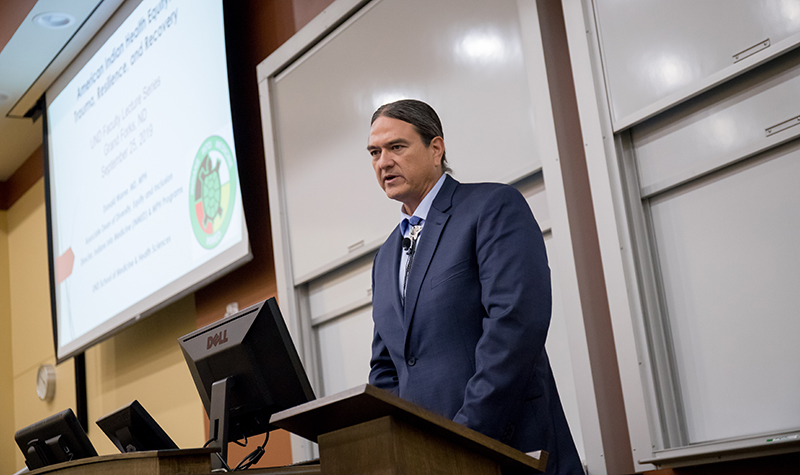
In front of a record crowd, Dr. Don Warne, associate dean for diversity, equity and inclusion at the School of Medicine & Health Sciences at UND, delivered the first lecture of the 2019-20 Faculty Lecture Series. Guest speakers introducing Warne included North Dakota Gov. Doug Burgum and First Lady Kathryn Burgum as well as UND President Joshua Wynne. Photo by Connor Murphy/UND Today.
Three sisters are walking along a river, said Dr. Donald Warne, director of UND’s Indians into Medicine and Master of Public Health programs, telling a story in the Oglala Lakota tradition to the audience in the crowded UND lecture hall.
“And as the sisters are walking along the river, they see babies and young children in the water, struggling to stay afloat,” Warne said.
“So the first sister says, ‘This is an emergency! This is a crisis! We have to get the babies out of the water right now!’
“The second sister thinks about that and says, ‘No, we need to teach them how to swim — so they can survive while they’re in the water.’
“And the third sister starts walking upstream,” Warne said.
“The other two get angry with her and say, ‘Where you going? Why aren’t you helping us?’
“And she says, ‘I’m going to find out who’s putting those babies in the water. And I’m going to stop them.’”
Warne paused.
“That’s public health,” he told the audience.
“That’s literally working further upstream. And when I think about the challenges that we face, there’s so much upstream work that we need to do, whether we’re talking about addiction or any other chronic disease.”
Fortunately, “there’s much that can be prevented,” especially when modern medical and public-health techniques are integrated with traditional American Indian healing practices, Warne said.
A member of the Oglala Lakota Tribe in Pine Ridge, S.D., Warne’s also the associate dean for diversity, equity and inclusion at the School of Medicine & Health Sciences at UND. And on Wednesday, he spoke on “American Indian Health Equity: Trauma, Resilience & Recovery” as the lead-off speaker in the UND Faculty Lecture Series for the 2019-20 academic year.
Among the 100-plus people who came to hear Warne — perhaps the most ever for a Faculty Lecture Series talks, said Bill Sheridan, Chester Fritz Distinguished Professor of Biology at UND — were Doug and Kathryn Burgum, governor and first lady of North Dakota.
“We support everything he’s trying to advance,” said the governor, speaking with UND Today before Warne’s talk.
The solutions Warne offers match up with the first lady’s initiative around Recovery Reinvented — an ongoing series meant to eliminate the shame and stigma of addiction in North Dakota — and with the Burgum administration’s efforts with tribal engagement as well, Gov. Burgum said.
“We think there’s a great intersection, and we’re grateful to be here. But we’re super-grateful that we have a national talent like Dr. Warne here in our state.
“I think what he’s doing is very important, and we’re here to learn and to listen.”

Doug and Kathryn Burgum, governor and first lady of North Dakota, have been longtime fans of Warne and attended his lecture. The governor told UND Today that the couple support Warne’s projects at UND. Photo by Connor Murphy/UND Today.
UND Interim President Joshua Wynne — who also attended and, along with Sheridan and the governor and first lady, spoke briefly to welcome the audience and introduce Warne — agreed.
“First, there is the importance of this series, which is a way to gather together faculty and scholars from across campus in one location so we can have a real exchange of ideas,” Wynne told UND Today.
“Hopefully, that’ll lead to further collaboration between and across schools.”
Second, “Don Warne in particular is obviously very active in the School of Medicine & Health Sciences,” Wynne said.
“But his scholarship and knowledge about — especially — American Indian populations and some of the health disparities that exist there, some of the opportunities to actually make positive gains, I think are lessons that other people on campus can profit from and probably figure out ways of collaborating on.
“Warne combines the attributes of being very knowledgeable and very well-connected with the tribes and very analytical,” Wynne continued.
“Good data and good analysis inform good decision-making and planning for the future. And that’s what Don Warne is really good at.”
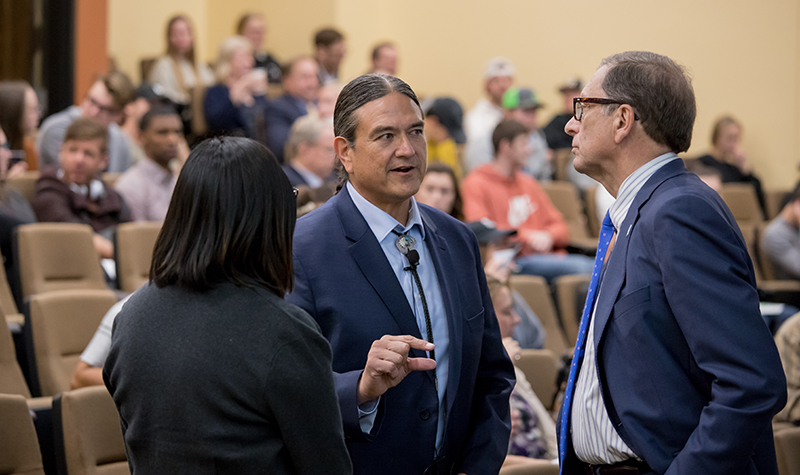
In his introduction of Warne, UND Interim President Joshua Wynne (right) praised Warne’s leadership and research at the UND School of Medicine & Health Sciences. Warne’s knowledge of and connection to tribal communities and analytical approach are an effective combination, the president said. Photo by Connor Murphy/UND Today.
The confluence
During Warne’s lecture, the graduate of Stanford’s School of Medicine and Harvard’s School of Public Health used UND’s location in Grand Forks to introduce his theme.
“The reason it’s called Grand Forks, of course, is that it’s a confluence — of the Red Lake River heading west, and the Red River heading north,” Warne said.
“That’s why this place is actually a sacred place for my people, Lakota and Dakota. This was a gathering place. Historically, we didn’t have highways, so we used the waterways for transportation; so what we now know as Grand Forks actually was a gathering point for my people.”
As a result, “every time I cross the bridge, I think about what the land must have looked like with a thousand tipis and 10,000 people,” Warne said.
“How beautiful that must have been.” And today, how meaningful it is to think of gathering points as a way of engaging everyone — especially underserved populations — and of integrating public health programs across the state.
That integration should include American Indian traditional cultural practices, especially when it comes to addressing American Indian health inequities, Warne suggested.
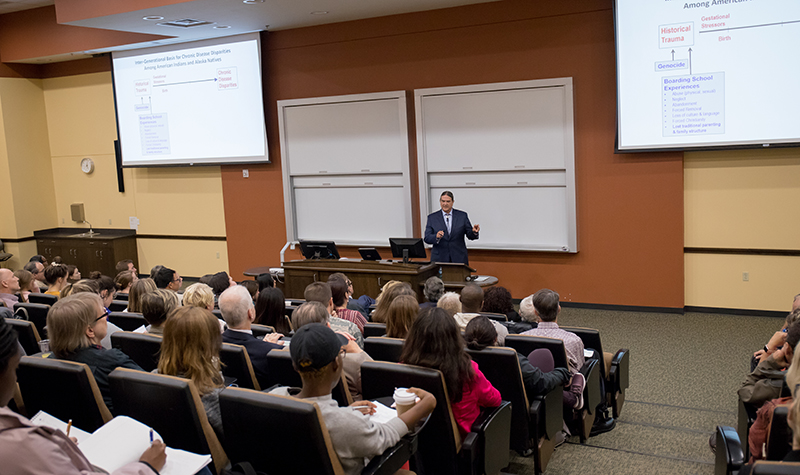
Warne pointed to adverse childhood experiences as a marker of stark inequities between American Indians and non-American Indians. Only 17 percent of the American Indian population has grown up without some form of abuse, neglect or other trauma, research suggests. Photo by Connor Murphy/UND Today.
Adverse Childhood Experiences
Those inequities are stark. For example, in a recent study that Warne helped conduct, American Indians in South Dakota reported significantly more adverse childhood experiences than did other groups in the state.
Adverse childhood experiences or ACEs are traumatic events that occur before age 18. Physical abuse, sexual abuse, household substance abuse, physical neglect, having a household member jailed, and other traumas: The more of these a child experiences, the more likely that person will experience addiction and other serious health problems as an adult.
Among non-American Indians, half the population had an ACE score of zero, meaning they hadn’t experienced any of those adversities, Warne said.
“Meanwhile, only 17 percent of the American Indian population had an ACE score of zero. That means 83 percent had some type of adverse childhood experience.
“This is screaming for intervention,” he said. “We need to do something about this.
“So, what can we do?”
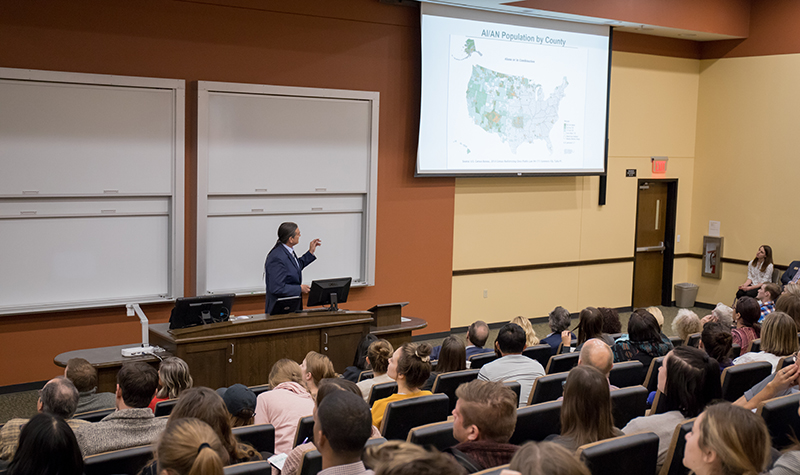
History was a key component of Warne’s lecture, as he described the impacts of European colonization and the massive plunge in indigenous populations across what is now the United States. Photo by Connor Murphy/UND Today.
Historical trauma
First, we can understand the deeply destructive role that historical trauma plays.
It’s estimated that at the time of contact with Europeans, about 5 million indigenous people lived in what’s now the United States, Warne said.
In 1890, the Census counted only 248,000 Native Americans. That fall-off came about from policies that can fairly be described as genocide, “and that has an impact on chronic disease disparities,” Warne said.
The good news is that the population has grown. The 2010 Census recorded 5.2 million people in the United States who identified as American Indian and Alaska Native.
The bad news is that “this is not ancient history,” Warne said.
“My mother is a survivor of boarding school” — institutions that were set up explicitly to destroy Indian culture.
“So there are still issues,” he said.
Full circle
Second, we can recognize the value of traditional American Indian practices in healing some of these wounds.
“When I go to this part of the discussion, I like to go over a brief history of medicine. A very brief history,” he said as the crowd laughed.
In 2000 B.C., medical advice basically amounted to “Here, eat this root.” In 1000 A.D., it was “That root is heathen; here, say this prayer.”
1800: “That prayer is superstition. Here, drink this potion.”
1900: “That potion is snake oil. Here, swallow this pill.”
1950: “That pill is ineffective. Here, take this antibiotic.”
Which brings us to 2000, when it’s “That antibiotic is artificial. Here, eat this root,” Warne said to more laughter.
“So, we’ve kind of come full circle.”
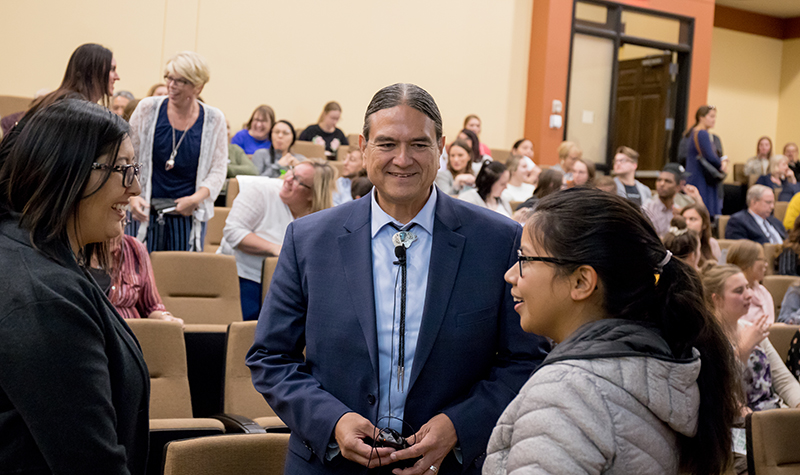
Though modern medicine has achieved many breakthroughs, Warne posits that spirituality and the natural world also are vital components of healing. Photo by Connor Murphy/UND Today.
And in fact, there’s wisdom in that laughter, because society is right to recognize the healing power that spirituality and the natural world have to offer.
“It’s outstanding, the achievements we’ve made in physical heath,” said Warne, an M.D.
“But it doesn’t always answer the issues that we’re dealing with. If someone has suffered through adversity and trauma in their childhood, there’s not a prescription that’s going to fix that. The answer is not in the pharmacy.”
Instead, the answer is in a much more holistic way of healing — one that integrates modern medicine with traditional practices such as spirituality.
“When I think about my own training, the only time the word spirituality came up was when I was in my hospice rotation,” he said.
“We had to wait until there was an impending death before we even acknowledged that there was spirituality. That’s completely the opposite of what we would do in a traditional Lakota way.”
That traditional way could involve such things as a healer praying with the patient, meditating with him or her and involving the family and entire community in the process.
“For those of us who participate in healing ceremonies, the power that you feel when you know your whole community wants you to do better is indescribable,” Warne said.
“We don’t tap into that very well in modern medicine.”
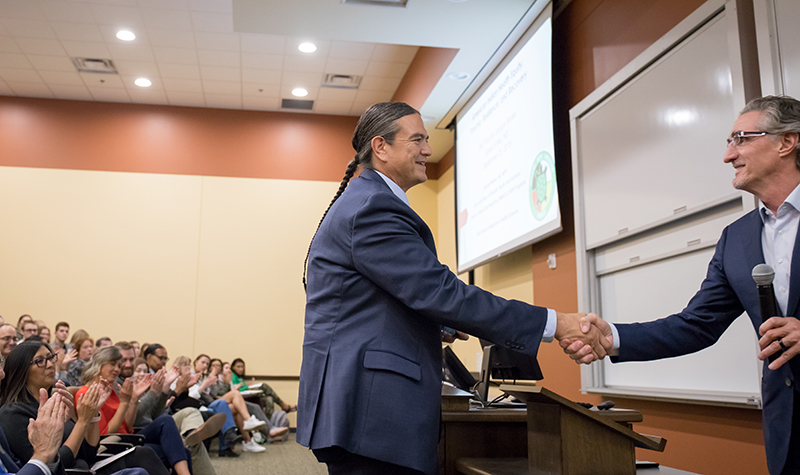
Warne, seen here shaking hands with Gov. Burgum, sees equity as achievable, in part by integrating modern medicine with traditional American Indian healing practices. Photo by Connor Murphy/UND Today.
Facing the wind
Importantly, efforts already are underway to achieve this integration, notably in North Dakota and at UND, Warne said. First Lady Kathryn Burgum, herself a recovering addict, supports holistic and spiritual approaches to addiction when she speaks around the state. Gov. Doug Burgum does the same via efforts such as Free Through Recovery, which boosts access to community-based behavioral health services for people in the criminal justice system who have substance addictions or mental illnesses.
At UND, the Indians into Medicine or INMED program has graduated more than 240 American Indian physicians since the program’s founding in 1973. “And as far as I’m concerned, we’re just getting started,” Warne said.
Moreover, the university’s new master’s degree program in Indigenous Health is expanding.
And next fall, the program will offer the first-ever Indigenous Health Ph.D.
Warne closed with a slide of a shaggy buffalo standing stalwart in the snow and wind.
“We learn a lot from other creatures,” Warne said.
“When we look at herds of buffalo, for example, we see that the strongest bulls are the ones standing in front of the rest of the herd, facing the wind and absorbing as much of it as they can.
“And I look at this as an opportunity for all of us to be that courageous buffalo, standing in front of those who are more vulnerable” he said.
“I see a lot of that in North Dakota – in our governor, first lady and UND president. I see that in many others who work here.
“And that’s the only way we’re going to achieve equity: by respecting culture and focusing on resilience, while facing the challenges head-on.”
* * *
2019-2020 Faculty Lecture Series
Nov. 20: Nuri Oncel, associate professor of physics & astrophysics – ‘Have you ever seen an atom?’
Feb. 19: Surojit Gupta, associate professor of mechanical engineering


